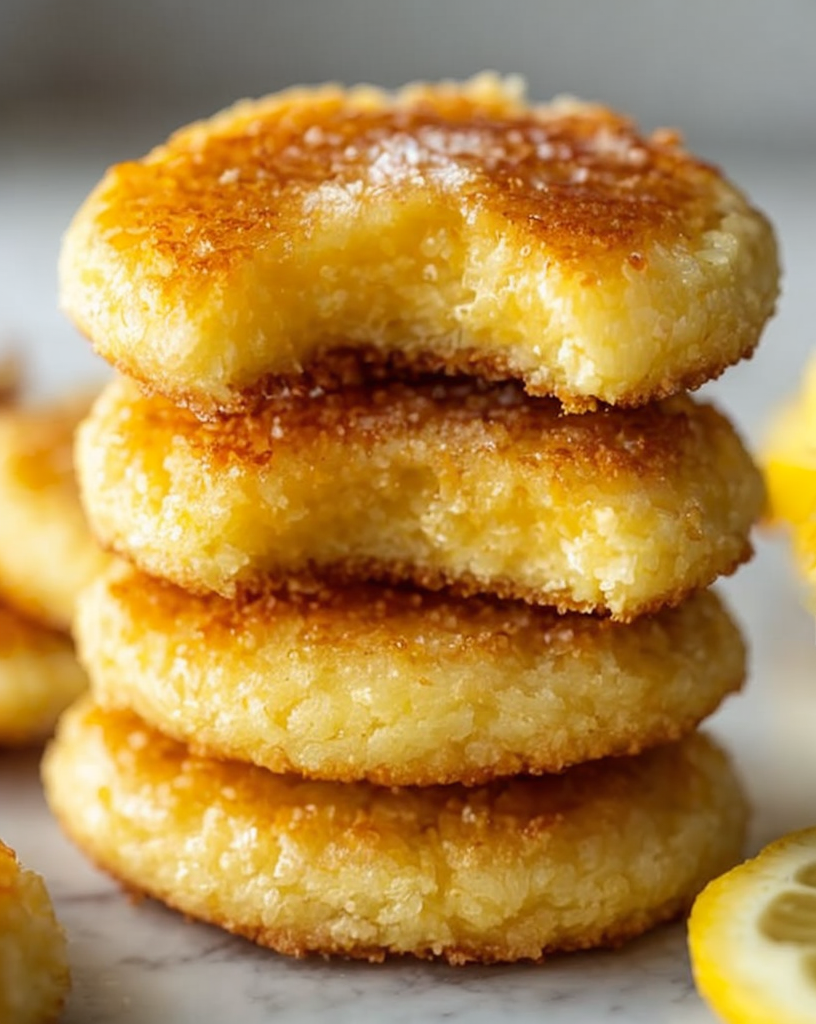Luscious Lemon Curd Crème Brûlée Cookies: A Symphony of Citrus and Cream
Lemon Curd Crème Brûlée Cookies are a delightful fusion of two timeless classics: the caramelized allure of crème brûlée meets the zesty freshness of lemon curd. Each bite of these cookies offers a burst of citrus, followed by a creamy, rich finish that melts in your mouth. The cookies are crowned with a thin layer of torched sugar, delivering that beloved crackling texture that mirrors the iconic French dessert. Perfect for afternoon tea or as a sophisticated treat at dinner parties, these cookies will effortlessly captivate your senses and heart.
The introduction of lemon curd to the crème brûlée essence infuses the cookies with a unique tangy punch, enveloping the taste buds in a vibrant tableau of sweet and tart flavors. Their enticing aroma—a fragrant blend of caramelized sugar and citrus—will invite everyone to gather around the baking tray as soon as they emerge from the oven. The preparation might require a touch of patience, but the reward is a batch of cookies that balances elegance with comfort in every bite.
Quick Recipe Highlights
- Flavor Profile: Tart lemon offsets the sweetness of caramelized sugar, creating a balanced taste that pleases both citrus lovers and dessert enthusiasts.
- Texture: The cookie boasts a soft, chewy base paired with a crackling sugar top, just like traditional crème brûlée.
- Aroma: Zesty lemon notes combined with buttery, baked aromas, finished with a hint of caramel from the brûlée topping.
- Visual Appeal: Presented in a golden-brown hue with a glossy, torched sugar glaze.
- Skill Level Needed: Intermediate baking skills are ideal to master the brûlée topping technique.
- Special Equipment: A kitchen torch is essential for achieving the perfect caramelized sugar layer.
Recipe Overview
- Difficulty Level: This recipe is considered medium due to the precise technique needed for the brûlée topping and the balance of flavors involved.
- Category: These cookies are a perfect dessert option, fitting within the gourmet snack category.
- Cuisine: The cookies are a creative blend of French-inspired crème brûlée technique with a modern baking twist.
- Cost: With ingredients like lemons and cream-based elements, the recipe is moderate in cost, staying affordable for most home bakers.
- Season: Best enjoyed in spring and summer when lemons are freshest, but their cozy charm extends well into the fall season.
- Occasion: Ideal for festive gatherings, afternoon teas, and as a sophisticated treat for special occasions.
Why You’ll Love This Recipe
Get ready to fall in love with these Lemon Curd Crème Brûlée Cookies because they offer a flavor and texture like no other. The balance of bright lemon with the deep, rich caramelization of sugar transports you straight to Paris with each bite. The dual nature of these cookies makes them an exciting treat, combining nostalgia with novelty. As the top cracks under gentle pressure, the aroma of freshly caramelized sugar meets a hint of lemon, evoking a sense of warmth and comfort with a splash of zest.
Convenience is another reason you’ll keep coming back to this recipe. With straightforward ingredients and manageable steps, you’ll find these cookies are easier to make than they look. Though the torched sugar topping may sound intimidating, it’s surprisingly easy to master and adds professional flair to your homemade creations. What’s more, the preparation doesn’t require any specialized kitchen devices apart from a torch, making it accessible for home bakers.
Nutritionally, while these cookies indulge your sweet tooth, the use of lemon introduces a source of vitamin C and adds a natural, refreshing element that can make you feel a bit better about indulging. Unlike denser desserts, these cookies offer a lighter finish, leaving you satisfied but not overburdened by sugar.
Beyond the taste, these cookies are ideal for sharing. Whether you’re attending a potluck, gearing up for a picnic, or having friends over for tea, these cookies are sure to impress and be the talk of the table. They invite conversation and admiration, often leading to requests for your secret recipe.
Finally, considering the cost and accessibility of the ingredients, these cookies offer an affordable luxury. Lemon, sugar, and basic baking ingredients are staples in most kitchens, ensuring that whipping up a batch won’t require a last-minute supermarket scramble. This blend of elegance, ease, and affordability makes these cookies a staple for both casual and special moments.
Historical Background and Cultural Significance
The interplay of lemon and sugar in desserts is a tale as old as time, with each ingredient holding deep roots in culinary traditions. Lemon itself has journeyed from Asia through the Mediterranean, primarily used as a condiment and preservative before it sweetened desserts. Its role in enhancing flavors is reflected in countless classic pastries, with English lemon curd being a long-time favorite in teatime pursuits.
Crème brûlée, meanwhile, is deeply woven into the rich tapestry of French culinary history. This decadent dessert with its creamy core and signature caramelized top has been a staple on fine dining menus since the 17th century. Marrying this luxurious custard topping with a cookie base allows for a portable, snackable version of a seemingly extravagant dessert experience.
As this recipe combines elements of both English and French traditions, it tells a story of cultural integration—the merging of techniques and ingredients to create something innovative. In recent years, cookies patterned after popular desserts have become common variability in American bakeries, signifying a trend of breaking conventional boundaries through creative baking.
The Lemon Curd Crème Brûlée Cookie is a prime example of regional variations colliding to deliver a dish that’s universally appealing and gastronomically inclusive. Whether served as a homage to European flavors or as a new-age confection, these cookies capture both historical significance and modern cooking innovation.
Ingredient Deep Dive
Lemon, the star of this recipe, holds significant cultural value across cuisine geographies. Known for its bright flavor, the inclusion of lemon curd provides the intense zest that gives these cookies their defining characteristic. Historically used in diverse ways—from medicinal outbreaks in ancient civilization to culinary essentials—the lemon enriches many dishes beyond Western-only cookery. Its powerful vitamin C content isn’t just a boon for health; it’s this nutrient that’s often connected with enhancing well-being and offering immune support, especially during seasonal changes.
When selecting your lemons, opt for ones that are firm and bright with no discoloration or soft spots, as these will yield more juice and zest. Store them at room temperature if planning to use soon or refrigerate to extend their lifespan. Should fresh lemons be unavailable, bottled lemon juice can substitute, though zest is best obtained using fresh fruit.
Sugar, another principal element, here takes center stage as a transformative agent in both taste and texture. Historically seen as a luxury, it’s now a globally accessible staple. Granulated sugar provides the necessary structural bulk for these cookies, while its caramelization when torched gives that signature brûlée adventure. Store sugar in a cool, dry place to prevent clumping, and ensure proper technique with your torch for that perfect thin and glass-like finish.
Common Mistakes to Avoid
- Overmixing the dough can lead to tough cookies. Mix until just combined for optimal softness.
- Using cold ingredients for the dough, which can prevent proper blending and give uneven textures.
- Not chilling the dough before baking, which can cause spreading, altering the final shape.
- Forgetting to zest the lemons before juicing, which makes it harder to extract the zest.
- Using old lemons may diminish flavor intensity; opt for fresh, fragrant lemons.
- Caramelizing the sugar unevenly; use continuous, even strokes with the torch.
- Not allowing the cookies to cool before torching, which can cause the caramelized sugar to melt off.
- Skipping the parchment paper; it helps prevent cookies from sticking and promotes even baking.
Essential Techniques
Achieving the perfect caramelization on your cookies is the crux of this recipe. Caramelization contributes both flavor and texture not easily achieved by other methods. Ensure your sugar layer is thin and even before applying the kitchen torch. Hold the torch a few inches above and move it in circular motions, aiming for a light, golden-brown color without burning the sugar. The visual cue for success is when the sugar bubbles evenly across the cookie’s surface.
Mastering balance when combining your wet and dry ingredients is also crucial. Overmixing not only affects texture but can initiate gluten development, which leads to denser cookies. Stir until the flour streaks just disappear for the perfect dough consistency. Watch for a visual cue of homogeneity without overworking.
Pro Tips for Perfect Luscious Lemon Curd Crème Brûlée Cookies
Use room temperature butter to achieve a creamy, smooth cookie dough that blends evenly with other ingredients.
Ensure lemon curd is thick; you may need to reduce homemade versions on the stove to prevent excess liquid in the dough.
Freeze the dough discs briefly before baking to keep the cookies from spreading too much in the oven.
Invest in a quality kitchen torch; a weak flame can cause uneven caramelization.
Rotate the baking tray halfway through baking for consistent heat distribution.
Zest the lemons over the mixing bowl for optimal flavor infusion, allowing oils to capture directly into the dough.
Experiment with a pinch of salt in the caramelization phase for a sweet-salty twist that enhances flavor depth.
Adjust torch height based on desired caramel intensity, remembering proximity increases temperature rapidly.
Variations and Adaptations
For regional variations, consider swapping lemon for lime or orange zest for a different citrus twist. Each variant adds its unique flair while maintaining the refreshment that citrus is known for.
To adapt the recipe for the fall, incorporate a hint of cinnamon into the dough, complementing the citrus with warm, spicy notes.
For those with dietary preferences, a gluten-free flour blend can replace traditional wheat flour, though checking for compatibility is key.
Flavor variations are possible by infusing herbs like rosemary or thyme into the lemon curd, adding an earthy complexity to the profile.
Texture modifications can be achieved by integrating nuts, such as slivered almonds or crushed pistachios, into the dough for a crunchy bite.
For an elegant presentation, drizzle or pipe additional lemon curd over cooled, brûléed cookies.
Serving and Presentation Guide
When plating these cookies, consider stacking them neatly on a clean, white plate to emphasize their vibrant glaze. Garnish with thin citrus slices or candied lemon peel to draw attention to the cookie’s core flavors.
Traditional accompaniments include a hot tea or espresso, serving to complement the cookies’ sweetness with a slightly bitter, acidic edge.
For a modern twist, pair with a fruit-infused iced tea or a zest-topped panna cotta for cohesive, citrus-themed culinary experience.
Ensure cookies are room temperature or slightly warm (never chilled) to enhance their full aromatic profile upon serving.
Maintain uniform size to allow consistent portioning, ensuring each guest explores an identical taste sensation.
Wine and Beverage Pairing
Serve these cookies with a crisp, floral white wine such as a Viognier or Riesling. These options will beautifully accentuate the lemon’s zest without overpowering its gentle tang.
For non-alcoholic alternatives, a sparkling lemonade or herbal iced tea can provide a refreshing counterpoint to the cookies’ sweetness.
Coffee or tea enthusiasts may opt for a delicate chamomile or an aromatic Earl Grey, both providing subtle nods to the dessert’s citrus notes.
Temperature plays a role; serve drinks slightly chilled to match the cookie’s light freshness, yet not ice cold to maintain nuanced flavors.
Consider a small dollop of whipped cream on the side, enhancing richness while serving as a neutral palate cleanser between sips and bites.
Storage and Shelf Life
To store these cookies optimally, place them in an airtight container at room temperature, where they will remain fresh for up to three days. Avoid refrigeration, as the cookies can lose their signature crackling top due to moisture.
For longer-term storage, freeze the uncooked dough instead of fully baked cookies. Roll and cut dough before freezing, individually wrapping in parchment or cling film. Thawing must be even—prefer overnight refrigeration or quick counter time—before baking and caramelizing.
Check for spoilage by focusing on texture changes; a softened sugar topping indicates moisture infiltration and signals aging.
Best practices for reheating (to rejuvenate sugar top) involve a brief broiler session, maintaining a safe distance to prevent burning.
Freeze finished cookies in a single layer before transferring to storage to keep from sticking and preserve structure.
Make Ahead Strategies
Initiate preparation the day before an event to ensure flavor deepens while maintaining freshness. Dough can be made ahead and refrigerated, making it efficient for day-to-day planning. Ensure dough returns to collectable temperature before baking.
Divide the recipe steps into manageable parts—lemon curd preparation, dough crafting, sugar torching—to allow breaks and optimize quality at each stage. During leisure intervals, store components separately to prevent amalgamation before final bake.
Bear in mind the quality may gradually shift with time; however, when made with fresh ingredients, retention is generally stable over a few days. Assemble at key moments to maintain freshness.
Scaling Instructions
When halving the recipe, pay close attention to measurements to ensure precision, especially in baking. Biased portions can significantly alter consistency and flavor strength.
Doubling or tripling will require extended baking times; adjust in increments to prevent uneven baking. Balance scales through adjustable heating mechanics and temperature sensors.
Multiply equipment usage accordingly, permitted by space and efficiency. Factor in cooling durations to ensure proceed accurately.
Freezing remains a core component when planning bulk; portion dough into individual cookies before freezing for hassle-free bakery pleasures on demand.
For uniformity, check adjustment compatibility per oven brand; natural variations in heaters result in time differences needing manual tweaks.
Nutritional Deep Dive
With a rich blend of flavors and ingredients, these cookies maintain an acceptable balance of macronutrients without over saturation in sugars. Each bite contains carbohydrates from sugar and flour, protein from eggs and flour, complemented by slight fat contents, primarily from butter.
Micronutrients are relatively minimal yet include vitamins from lemon zest, particularly vitamin C, enhancing overall nutritional appeal.
Dieters indulging in moderation can fit these cookies into broader, responsible eating habits, supported by mindful counting and portion acceptance.
Each cookie offers a representation of possibilities, allowing indulgers to explore traditional desserts amid health-focused consciousness.
Weight management tips center around portion control; servings should remain moderate to balance the addressed desire of sweet cravings with healthy intake goals.
Dietary Adaptations
For gluten-free variations, consider a 1:1 gluten-free baking flour replacement to maintain comparable texture and taste. Be mindful of potential cross-contaminations and choose certified gluten-free products for sensitive diets.
A dairy-free experiment can employ plant-based butters or oils, maintaining a similar flavor profile with slight modifications. Simply avoid dairy-based versions of ingredients, instead selecting any allergens-permitting alternatives.
For a vegan take, replace eggs with flax or chia seeds (1 tablespoon with 3 tablespoons water per egg). Special ovens and tools may ensure adaptation success, considering attribute affects.
For low-carb or keto directions, sugar replacements, including erythritol or stevia, can preserve sweetness with less glycemic impact. Almond flour as a flour base utterly omits gluten with effective result reflections.
Other dietary needs and specifications can be met by simple exchanges, such as butters or oils with coconut variations, maintaining the foundational experience of great lemon custard cookies.
The Recipe
Luscious Lemon Curd Crème Brûlée Cookies
Serves: 24 cookies
Prep Time: 20 mins
Cook Time: 15 mins
Total Time: 35 mins
Kitchen Equipment Needed
- Baking sheet
- Mixing bowls
- Spoon or spatula
- Citrus zester
- Measuring cups and spoons
- Kitchen torch
- Wire rack
- Parchment paper
Ingredients
- 2 cups all-purpose flour
- 1/2 teaspoon baking powder
- 1/4 teaspoon salt
- 1/2 cup unsalted butter, at room temperature
- 1 cup granulated sugar (divided)
- 1 large egg
- 1 teaspoon vanilla extract
- Zest of 2 lemons
- 1/2 cup lemon curd
Directions
- Preheat the oven to 350°F (175°C) and line a baking sheet with parchment paper.
- In a small bowl, mix together flour, baking powder, and salt. Set aside.
- In a large bowl, cream the butter and 3/4 cup of the sugar until light and fluffy.
- Add the egg and vanilla extract, mixing until combined.
- Stir in lemon zest and lemon curd until incorporated.
- Gradually add dry ingredients to the wet mixture, stirring just until combined.
- Drop rounded tablespoons of dough onto the prepared baking sheet, spacing them about 2 inches apart.
- Bake for 10-12 minutes or until the edges start to golden. Cool on baking sheet for 5 minutes, then transfer to a wire rack to cool completely.
- Sprinkle the tops of cooled cookies with remaining sugar. Use a kitchen torch to carefully caramelize the sugar.
- Allow sugar to cool and harden completely before serving.
Recipe Notes
- For a richer flavor, consider browning the butter before combining it with sugar.
- Store cookies in an airtight container and plan to consume within three days for best texture.
- Replace lemon zest with lime or orange for a zesty variation.
Troubleshooting Guide
– Ensure the sugar caramelizes evenly by keeping the torch constantly moving and at a safe, controlled distance to prevent burning.
– Should the cookie feel overly dense post-bake, review dough mixing steps to avoid overworking and potentially explore ingredients substitute options for an airy touch.
– If the sugar topping appears dull rather than glossy, it may not have been properly caramelized. Ensure subsequent torching maintains an even, satisfactory sheen.
– In cases of ingredient unavailability, lemon zest may be sourced using different citrus fruits, like limes or oranges, for adjustments without flavor loss.
– Should cookies exhibit spread more than anticipated, review chill states prior to bake and experiment with colder dough preparations.
Recipe Success Stories
In our community, bakers worldwide have shared their delightful experiences recreating this recipe at events ranging from charity fundraisers to intimate family gatherings. Many noted the straightforward transition from conventional to specialty ingredients, writing that even adaptations yielded beautiful results.
Report by feedback shows readers favored combining zest with batter over a mixing bowl, a clever tip, unveiling aromatic oils that embedded their cookies with stronger citrus punches.
Seeing photo delicacies published online, our readers rave frequently over photography techniques such as natural light and rustic plating turning simple bakes into masterful culinary portraits.
Frequently Asked Questions
A: Yes, store-bought lemon curd works just as well and saves preparation time. Adjust sweetness to taste, if necessary.
Q: Do I need a stand mixer to make these cookies?
A: No, a hand mixer or sturdy spatula will work perfectly for mixing these ingredients. Just ensure a thorough blend.
Q: Is there a suitable egg substitute for this recipe?
A: Use 1 tablespoon of ground chia seeds mixed with 3 tablespoons of water per egg as a vegan alternative.
Q: Can I freeze the dough ahead of time?
A: Yes, you can roll the dough into a log and wrap it securely before freezing. Allow to thaw in the fridge before slicing and baking.
Q: What if I don’t have a kitchen torch?
A: You can place cookies under the broiler for a few minutes to mimic the torching effect, but monitor closely to avoid burning.
Q: How can I store leftover cookies?
A: Store them in an airtight container at room temperature to maintain their texture. Keep away from humidity and consume within three days.
Q: Will reducing sugar alter the final result significantly?
A: Reducing sugar may impact the structure and taste. If sugar intake is a concern, explore artificial sweetener substitutes that bake similarly.
Q: My cookies seem too soft after baking; what did I do wrong?
A: Ensure proper dough chilling and adequate bake time. Adjust baking time in 2-minute increments until the desired firmness is reached.
Q: Can I make the cookies without lemon zest?
A: While zest enhances flavor significantly, it can be omitted. Consider adding a touch of lemon extract to retain some citrus essence.
Q: Are there alternative options for the caramelized sugar topping?
A: Yes, try a dusting of powdered sugar or dip tops in melted white chocolate for a different sweet finish.
Additional Resources
Explore the journey of perfecting lemon-based desserts in our comprehensive guide to citrus baking. From lemon tarts to creamy custards, discover ways to enhance everyday sweets with zest and juiciness.
Seasoned bakers share secret tips on mastering the brûlée technique and creating flawless sugar toppings without stress. With video tutorials and visual step-by-step guides, elevate your skills one caramelized layer at a time.
In-depth ingredient highlights discuss sugar’s intricate role in desserts, spanning from caramel syrup creation to overall texture enhancement, transforming baker novices into knowledgeable sweet confection engineers. Wondering what tool helps prevent overbrowning? Peruse our equipment directory for highlights.
Join the Conversation
Share your own delightful baking accomplishments by tagging us on social media and using the hashtag #LemonBruleeBakes. Inspire others with your creations and dive into community discussions on flavor innovations, presentation triumphs, and baking dynamics.
Engage with peers to discuss analysis and present exciting photographic storytelling, covering stages from initial mixing to final aesthetic presentation. Share, learn, review, and reshape the traditional cookie scene into customized leisure pursuits.
We encourage you to become a part of our vibrant community, offering feedback, suggestion iterations, and thematic discussions surrounding this unique and tantalizing lemon crème brûlée treasure.



